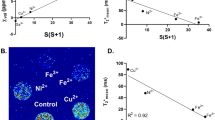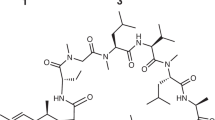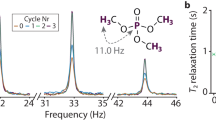Abstract
Nuclear magnetic resonance1,2 (NMR) is one of the most versatile experimental methods in chemistry, physics and biology3, providing insight into the structure and dynamics of matter at the molecular scale. Its imaging variant—magnetic resonance imaging4,5 (MRI)—is widely used to examine the anatomy, physiology and metabolism of the human body. NMR signal detection is traditionally based on Faraday induction6 in one or multiple radio-frequency resonators7,8,9,10 that are brought into close proximity with the sample. Alternative principles involving structured-material flux guides11, superconducting quantum interference devices12, atomic magnetometers13, Hall probes14 or magnetoresistive elements15 have been explored. However, a common feature of all NMR implementations until now is that they rely on close coupling between the detector and the object under investigation. Here we show that NMR can also be excited and detected by long-range interaction, relying on travelling radio-frequency waves sent and received by an antenna. One benefit of this approach is more uniform coverage of samples that are larger than the wavelength of the NMR signal—an important current issue in MRI of humans at very high magnetic fields. By allowing a significant distance between the probe and the sample, travelling-wave interaction also introduces new possibilities in the design of NMR experiments and systems.
This is a preview of subscription content, access via your institution
Access options
Subscribe to this journal
Receive 51 print issues and online access
$199.00 per year
only $3.90 per issue
Buy this article
- Purchase on Springer Link
- Instant access to full article PDF
Prices may be subject to local taxes which are calculated during checkout





Similar content being viewed by others
References
Bloch, F., Hansen, W. W. & Packard, M. The nuclear induction experiment. Phys. Rev. 70, 474–485 (1946)
Purcell, E. M., Torrey, H. C. & Pound, R. V. Resonance absorption by nuclear magnetic moments in a solid. Phys. Rev. 69, 37–38 (1946)
de Graaf, R. A. NMR Spectroscopy (Wiley, 2007)
Lauterbur, P. C. Image Formation by Induced Local Interactions: Examples Employing Nuclear Magnetic Resonance. Nature 242, 190–197 (1973)
Kumar, A., Welti, D. & Ernst, R. R. NMR Fourier zeugmatography. J. Magn. Reson. 18, 69–83 (1975)
Hahn, E. L. Nuclear induction due to free Larmor precession. Phys. Rev. 77, 297–298 (1950)
Hayes, C. E., Edelstein, W. A., Schenck, J. F., Mueller, O. M. & Eash, M. An efficient, highly homogeneous radiofrequency coil for whole-body NMR imaging at 1.5 T. J. Magn. Reson. 63, 622–628 (1985)
Tropp, J. Theory of the birdcage resonator. J. Magn. Reson. 82, 51–62 (1989)
Roemer, P. B., Edelstein, W. A., Hayes, C. E., Souza, S. P. & Mueller, O. M. The NMR phased array. Magn. Reson. Med. 16, 192–225 (1990)
Vaughan, J. T., Hetherington, H. P., Otu, J. O., Pan, J. W. & Pohost, G. M. High frequency volume coils for clinical NMR imaging and spectroscopy. Magn. Reson. Med. 32, 206–218 (1994)
Wiltshire, M. C. K. et al. Microstructured magnetic materials for RF flux guides in magnetic resonance imaging. Science 291, 849–851 (2001)
Day, E. P. Detection of NMR using a Josephson-junction magnetometer. Phys. Rev. Lett. 29, 540–542 (1972)
Savukov, I. M. & Romalis, M. V. NMR detection with an atomic magnetometer. Phys. Rev. Lett. 94, 123001 (2005)
Boero, G., Besse, P.-A. & Popovic, R. Hall detection of magnetic resonance. Appl. Phys. Lett. 79, 1498–1501 (2001)
Verpillat, F. et al. Remote detection of nuclear magnetic resonance with an anisotropic magnetoresistive sensor. Proc. Natl Acad. Sci. USA 105, 2271–2273 (2008)
Vaughan, T. et al. 9.4T human MRI: Preliminary results. Magn. Reson. Med. 56, 1274–1282 (2006)
Atkinson, I. C., Renteria, L., Burd, H., Pliskin, N. H. & Thulborn, K. R. Safety of human MRI at static fields above the FDA 8T guideline: Sodium imaging at 9.4T does not affect vital signs or cognitive ability. J. Magn. Reson. Imaging 26, 1222–1227 (2007)
Balanis, C. A. Antenna Theory: Analysis and Design 2nd edn, Ch. 14 (Wiley, 2005)
Bogdanov, G. & Ludwig, R. Coupled microstrip line transverse electromagnetic resonator model for high-field magnetic resonance imaging. Magn. Reson. Med. 47, 579–593 (2002)
Harpen, M. D. Cylindrical coils near self-resonance. Magn. Reson. Med. 30, 489–493 (1993)
Hoult, D. I. The principle of reciprocity in signal strength calculations: a mathematical guide. Concepts Magn. Reson. 12, 173–187 (2000)
Gulla, A. F. & Budil, D. E. Engineering and design concepts for quasioptical high-field electron paramagnetic resonance. Concepts Magn. Reson. B 22B, 15–36 (2004)
Boyd, R. W. Nonlinear Optics (Elsevier Science, 2003)
Kurnit, N. A., Abella, I. D. & Hartmann, S. R. Observation of a photon echo. Phys. Rev. Lett. 13, 567–568 (1964)
Armstrong, J. A., Bloembergen, N., Ducuing, J. & Pershan, P. S. Light waves at the boundary of nonlinear media. Phys. Rev. 128, 606–622 (1962)
McCall, S. L. & Hahn, E. L. Self-induced transparency. Phys. Rev. 183, 457–490 (1969)
Bock, N. A., Konyer, N. B. & Henkelman, R. M. Multiple-mouse MRI. Magn. Reson. Med. 49, 158–167 (2003)
Christ, A. et al. Development of CAD based anatomical human body models of two adults and two children. EBEA 2007, abstr. S-4-2 (8th Internat. Congr. Eur. BioElectromag. Assoc., 2007)
Acknowledgements
We thank N. van den Berg and A. Trabesinger for discussions. We are also grateful to P. Boesiger for his leading role in creating the 7T facility. This work was funded in part by the Swiss National Science Foundation (Project 116400) and by the Velux Foundation. Technical support from Philips Healthcare is also gratefully acknowledged.
Author Contributions D.O.B.: basic concept, antenna design and construction, bench experiments, magnetic resonance experiments, manuscript. N.D.Z.: conceptual considerations, assistance with antenna design, assistance with bench and magnetic resonance experiments, editing. J.F.: conceptual considerations, FDTD models, radio-frequency safety validation, editing. J.P.: FDTD models. K.P.P.: conceptual considerations, assistance with magnetic resonance experiments, manuscript, supervision.
Author information
Authors and Affiliations
Corresponding author
Rights and permissions
About this article
Cite this article
Brunner, D., De Zanche, N., Fröhlich, J. et al. Travelling-wave nuclear magnetic resonance. Nature 457, 994–998 (2009). https://doi.org/10.1038/nature07752
Received:
Accepted:
Issue Date:
DOI: https://doi.org/10.1038/nature07752
This article is cited by
-
A self-matched leaky-wave antenna for ultrahigh-field magnetic resonance imaging with low specific absorption rate
Nature Communications (2021)
-
Metamaterial Magnetic Sheet at 3.7-T MRI for Animal Imaging
Journal of Electronic Materials (2020)
-
Modeling of Electrically Triggered Tunable Magnetic Metamaterial Hat for Multifunctional Control in MRI Applications
Plasmonics (2019)
-
Sicherheit von Implantaten im Hochfeld- und Ultrahochfeld-MRT
Der Radiologe (2019)
-
Printed Receive Coils with High Acoustic Transparency for Magnetic Resonance Guided Focused Ultrasound
Scientific Reports (2018)
Comments
By submitting a comment you agree to abide by our Terms and Community Guidelines. If you find something abusive or that does not comply with our terms or guidelines please flag it as inappropriate.



